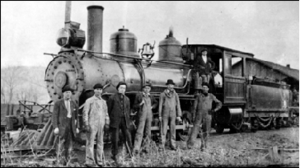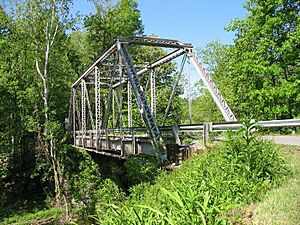East Tennessee and Western North Carolina Railroad facts for kids
| Overview | |
|---|---|
| Headquarters | Johnson City, Tennessee |
| Reporting mark | ET&WNC |
| Locale | North Carolina and Tennessee |
| Dates of operation | 1881–1950 (narrow gauge lines), 1983 (standard gauge lines) |
| Technical | |
| Track gauge | 3 ft (914 mm); 4 ft 8 1⁄2 in (1,435 mm) standard gauge |
The East Tennessee & Western North Carolina Railroad (ET&WNC) was a special train line. People often called it the "Tweetsie" because of its steam whistles. It started in 1866 to help the mines in Cranberry, North Carolina.
Most of the Tweetsie's tracks were "narrow gauge." This means they were narrower than regular train tracks (3 ft (914 mm) wide). This part of the ET&WNC closed in 1950. A regular-sized track (4 ft 8 1⁄2 in (1,435 mm) standard gauge) section, about 11 miles long, ran from Johnson City to Elizabethton, Tennessee. This part operated as the East Tennessee Railway until 2003. In 2012, these tracks were removed to create a walking and biking path. This path is now called the Tweetsie Trail.
Contents
The Tweetsie's Journey: A Railroad Story
The East Tennessee & Western North Carolina Transportation Company began on May 24, 1866. But it didn't have enough money, so the project stopped in 1874. Later, the Cranberry Iron Company took over the line between 1876 and 1879. They made the railroad one of their smaller businesses.
Building the First Tracks
The first 14.1 miles of track went through the Appalachian Mountains. It ran from Johnson City to Hampton, Tennessee, passing through Elizabethton. This part was finished on August 22, 1881. Ario Pardee, a financier from Pennsylvania, helped fund it. Thomas Matson, a famous railway engineer, provided the technical skills. A line extension to Cranberry opened on July 3, 1882.
Mountain residents soon called it the "Railway with a Heart." This was because railroad workers often ran errands for local people. They even let passengers ride for free during the Great Depression. Their tickets were even punched with a heart shape!
Trains and What They Carried
The ET&WNC used five special steam engines called Ten Wheelers, made by Baldwin Locomotive Works. These were engines #9, #10, #11, #12, and #14. They were all painted black at first. But later, they were painted green to look like the Southern Railway's bigger engines.
During World War II, fewer people rode the trains. So, it became too expensive to run a full passenger train every day. The ET&WNC used a special car, #15. This car had a post office and a place for luggage. Behind it, they would attach one or two "piggyback" flat cars. These cars carried truck trailers on them.

The ET&WNC mainly carried iron ore from the Cranberry mines. It also moved pig iron from local forges and lumber from North Carolina's forests. In 1913, the Cranberry Iron Company bought another line, the Linville River Railway (LRR). This line was built in the 1890s to carry lumber. The LRR was extended to Boone, North Carolina. However, a big flood in 1940 badly damaged its tracks. The line was closed in 1941. Much of North Carolina Highway 105 was later built along its old path.
After World War II
The ET&WNC was a major line for both passengers and goods during World War II. But business slowed down a lot after the war. The narrow gauge tracks from Elizabethton were soon closed. However, the ET&WNC kept running between Johnson City and the rayon factories in Elizabethton.
The tracks around Johnson City were "dual gauge." This meant they had three rails. This allowed both narrow gauge and standard gauge trains to use them. This helped connect with other railroads. The ET&WNC bought three standard gauge locomotives: #204, #205, and #206. These engines moved cars around the Johnson City area. The ET&WNC Railroad Company's narrow gauge lines officially stopped working on October 16, 1950. The tracks were removed the next year.

|
East Tennessee & Western North Carolina Railroad Locomotive No. 12
|
|
| Nearest city | Blowing Rock, North Carolina |
|---|---|
| Area | less than one acre |
| Built | 1917 |
| Architect | Baldwin Locomotive Works |
| NRHP reference No. | 92000147 |
| Added to NRHP | March 12, 1992 |
The Tweetsie Lives On!
In 1952, the last narrow gauge engines (#9, #11, and #12) were put up for sale. Engines #9 and #11 were offered for display in Elizabethton and Johnson City, but the offer was refused. So, #9 and #11 were scrapped. But engine #12 was bought by train fans and sent to Virginia. Later, movie cowboy Gene Autry bought it. He wanted to use it in his films in California.
After a lot of work to fix it up, locomotive #12 returned to North Carolina on May 23, 1957. It came with some of its original train cars. That summer, the "Tweetsie Railroad" opened. It became a new travel spot and family theme park. The train travels on a beautiful 3-mile (4.8 kilometers) loop through the mountains. It is near Blowing Rock, close to the old end-of-the-line station in Boone. The park uses two steam locomotives. Besides ET&WNC No. 12, they also have No. 190, the Yukon Queen. This engine came from Alaska in 1960. Tweetsie also has an old wooden coach, from the East Broad Top Railroad. It is used for special events.
Later Years and the Trail
The ET&WNC kept running its standard gauge lines long after the narrow gauge ones closed. In 1952, the railroad looked for new engines. They chose #630 and #722 because they were in good shape. These engines were renamed 207 and 208. They worked for the ET&WNC until December 8, 1967. Then, the Southern Railway traded two newer engines for them. Engine 630 is now at the Tennessee Valley Railroad Museum in Chattanooga, Tennessee. Engine 722 is at the Great Smoky Mountains Railroad in Bryson City, North Carolina.
The Green Bay Packaging Company bought the railroad in 1996. They renamed it the East Tennessee Railway (ETRY). This company is now part of Genesee and Wyoming, which runs smaller railroads around the world. The standard gauge line continued to move freight cars in Johnson City. It connected with trains from CSX and Norfolk Southern. This continued until October 10, 2003.
In 2012, the last ten-mile section of the ET&WNC between Johnson City and Elizabethton began to be removed. This was part of a Rails to Trail project. The first seven miles were finished in August 2014. The last three miles were done in August 2015. In 2016, Carter County started to "extend" this trail to Roan Mountain. This extension mostly uses existing roads, not the original train path. Today, the East Tennessee Railway uses very little track. It serves only a few businesses near the Johnson City yard.
Locomotives of the ET&WNC
| Number/Name | Wheel Arrangement |
Builder | Serial Number | Built | Retired | Notes |
|---|---|---|---|---|---|---|
| 1 "Watauga" | 2-6-0 | Baldwin Locomotive Works | 5403 | 12/1880 | 1912 | Bought new, sold in 1912. |
| 2 "Cranberry" | 2-6-0 | Baldwin Locomotive Works | 5746 | 8/1881 | 1910 | Bought new, sold in 1910. |
| 3 "Unaka" | 2-8-0 | Baldwin Locomotive Works | 6377 | 9/1882 | 1911 | Bought new, sold in 1911. |
| 4 | 2-8-0 | Baldwin Locomotive Works | 21114 | 10/1902 | 1940s | Bought new, worked on the Linville River Railway. Scrapped in the 1940s. |
| 5 | 2-8-0 | Baldwin Locomotive Works | 21893 | 3/1903 | 1940 | Bought new, went to Linville River as their #5. |
| 6 | 2-8-0 | Baldwin Locomotive Works | 24734 | 9/1904 | 1935 | Bought new, scrapped in the 1930s. |
| 7 | 0-8-0 | Alco-Brooks | 39951 | 6/1906 | 1940 | Bought new. Scrapped in the 1940s. |
| 1st #8 | 4-6-0 | Baldwin Locomotive Works | 31479 | 8/1907 | 1920 | Sold in 1920. Later scrapped. |
| 2nd #8 | 4-6-0 | Baldwin Locomotive Works | 37327 | 12/1911 | 1939 | Built as Twin Mountain & Potomac Railroad #2. Sold to ET&WNC in 1926. Scrapped 1939. |
| 9 | 4-6-0 | Baldwin Locomotive Works | 36440 | 4/1911 | 1950 | Bought new. Went to Linville River Railroad in 1919. Returned to ET&WNC in 1940. Scrapped in 1952. |
| 10 | 4-6-0 | Baldwin Locomotive Works | 42766 | 1/1916 | 1942 | Bought new. Sold to the White Pass and Yukon Route Railroad in 1942. Destroyed in a fire in 1943. Scrapped 1946. |
| 11 | 4-6-0 | Baldwin Locomotive Works | 42862 | 6/1916 | 1950 | Bought new. Last engine to run on the ET&WNC Narrow gauge lines in October 1950. Scrapped 1952. |
| 12 | 4-6-0 | Baldwin Locomotive Works | 45069 | 2/1917 | 1949 | Bought new. Sold in 1952. Sold to the Tweetsie Railroad in 1955 where it still runs today. Named "Tweetsie". |
| 14 | 4-6-0 | Baldwin Locomotive Works | 52406 | 9/1919 | 1942 | Bought new. Sold to the White Pass and Yukon Route Railroad in 1942. Destroyed in a fire in 1943. Scrapped 1946. |
| 28 | 2-6-0 | Baldwin Locomotive Works | 39697 | 8/1913 | 1936 | Built as Kentwood & Eastern #28. Sold to the Linville River Railroad in 1918. Scrapped in 1936. |
| Number/Name | Wheel Arrangement |
Builder | Serial Number | Built | Retired | Notes |
|---|---|---|---|---|---|---|
| 204 | 2-8-0 | Lima Locomotive Works | 16858 | 2/1922 | 1955 | Built as Alabama, Tennessee and Northern Railroad #204. Sold to ET&WNC in 1939. Scrapped 1955. |
| 205 | 0-6-0 | Baldwin Locomotive Works | 29768 | 12/1906 | 1952 | Built as Richmond, Fredericksburg and Potomac Railroad #104. Sold to ET&WNC in 1940. Sold in 1953. Scrapped 1956. |
| 206 | 2-6-0 | Brooks Locomotive Works | 3693 | 12/1900 | 1956 | Built as Illinois Central Railroad #556. Sold to ET&WNC in 1942. Scrapped in 1956. |
| 207 | 2-8-0 | Alco-Richmond | 28446 | 2/1904 | 12/8/1967 | Built as Southern Railway #630. Sold to ET&WNC in 1952. Traded back to Southern in 1967. Now working at the Tennessee Valley Railroad Museum. |
| 208 | 2-8-0 | Baldwin Locomotive Works | 24729 | 9/1904 | 12/8/1967 | Built as Southern Railway #722. Sold to ET&WNC in 1952. Traded back to Southern in 1967. Now waiting to be fixed up at the Great Smoky Mountains Railroad in Bryson City, North Carolina. |
| 828 | 2-8-0 | Baldwin Locomotive Works | 16858 | 7/1899 | 8/1937 | Built as Norfolk and Western Railway #828. Sold to ET&WNC in 1927. First standard gauge engine bought by ET&WNC. Scrapped 1937. |
| Number/Name | class | Builder | Serial Number | Built | Retired | Notes |
|---|---|---|---|---|---|---|
| 209 | RS-3 | American Locomotive Company | 78246 | 9/1950 | 1983 | Built as Central of Georgia Railway #108. Traded to ET&WNC by the Southern for 207 and 208. |
| 210 | RS-3 | American Locomotive Company | 78247 | 9/1950 | 1983 | Built as Central of Georgia Railway #109. Traded to ET&WNC by the Southern for 207 and 208. Now at the Tennessee Valley Railroad Museum. |



